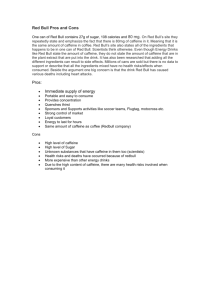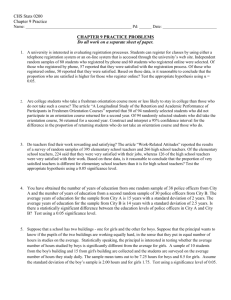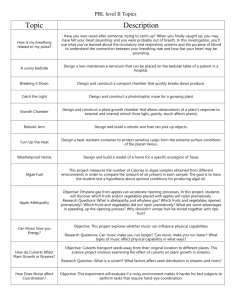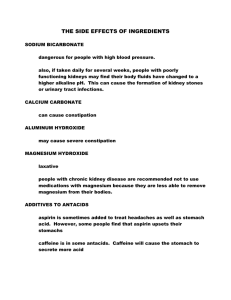Effects of caffeine ingestion on strength and
advertisement
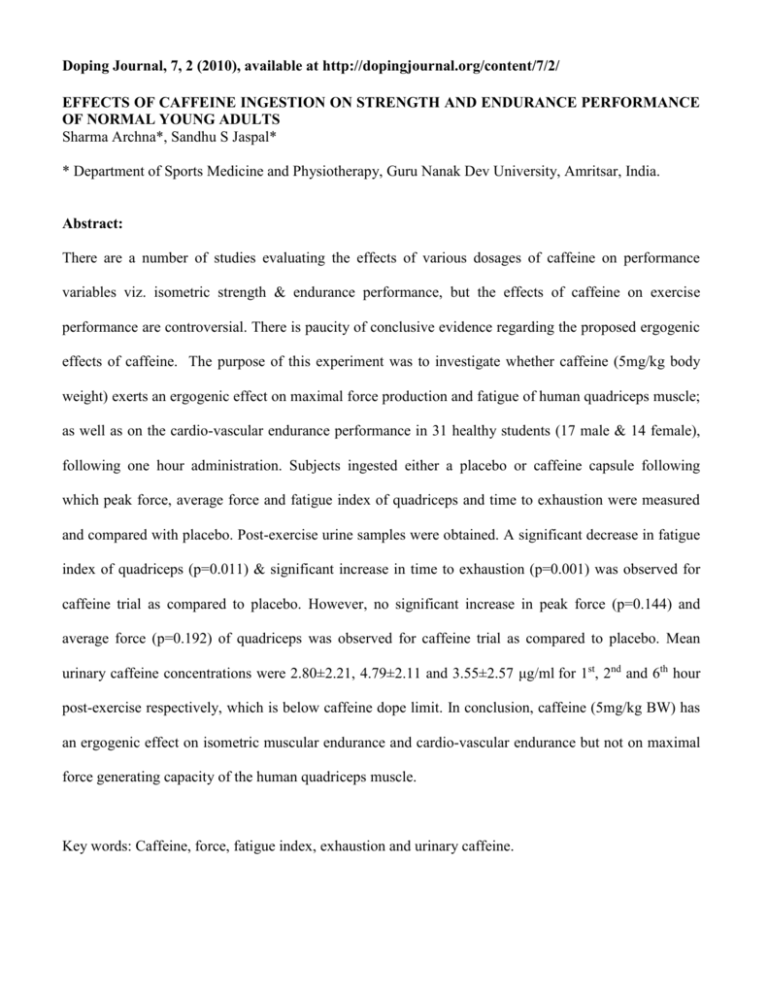
Doping Journal, 7, 2 (2010), available at http://dopingjournal.org/content/7/2/ EFFECTS OF CAFFEINE INGESTION ON STRENGTH AND ENDURANCE PERFORMANCE OF NORMAL YOUNG ADULTS Sharma Archna*, Sandhu S Jaspal* * Department of Sports Medicine and Physiotherapy, Guru Nanak Dev University, Amritsar, India. Abstract: There are a number of studies evaluating the effects of various dosages of caffeine on performance variables viz. isometric strength & endurance performance, but the effects of caffeine on exercise performance are controversial. There is paucity of conclusive evidence regarding the proposed ergogenic effects of caffeine. The purpose of this experiment was to investigate whether caffeine (5mg/kg body weight) exerts an ergogenic effect on maximal force production and fatigue of human quadriceps muscle; as well as on the cardio-vascular endurance performance in 31 healthy students (17 male & 14 female), following one hour administration. Subjects ingested either a placebo or caffeine capsule following which peak force, average force and fatigue index of quadriceps and time to exhaustion were measured and compared with placebo. Post-exercise urine samples were obtained. A significant decrease in fatigue index of quadriceps (p=0.011) & significant increase in time to exhaustion (p=0.001) was observed for caffeine trial as compared to placebo. However, no significant increase in peak force (p=0.144) and average force (p=0.192) of quadriceps was observed for caffeine trial as compared to placebo. Mean urinary caffeine concentrations were 2.80±2.21, 4.79±2.11 and 3.55±2.57 μg/ml for 1st, 2nd and 6th hour post-exercise respectively, which is below caffeine dope limit. In conclusion, caffeine (5mg/kg BW) has an ergogenic effect on isometric muscular endurance and cardio-vascular endurance but not on maximal force generating capacity of the human quadriceps muscle. Key words: Caffeine, force, fatigue index, exhaustion and urinary caffeine. Introduction In current day highly competitive sports environment, with surmountable pressure to perform, once the athlete reaches optimal level of performance according to its genetic makeup and after inputs to the maximum by scientific training procedures, biomechanical inputs, dietary modulation, psychological support, the subsequent increment in performance is to a big extent based on various ergogenic procedures followed by elite sportspersons as even a small enhancement in energy delivery system gives them a “winning edge”. Of the various ergogenic methods used by sportspersons to achieve athletic excellence caffeine consumption has become increasingly popular. Caffeine (1,3,7-trimethylxanthine), the world’s most popular stimulant drug, is a plant alkaloid found in coffee, tea, cola drinks, diet pills and cold medicines. Following absorption caffeine and its metabolites readily cross the blood-brain-barrier to produce analgesic effects on the CNS. Caffeine is equally distributed in intracellular fluid in the body 1 thus affecting the nervous, cardio-vascular and musculoskeletal systems. The caffeine content of a 6 ounce cup of brewed coffee varies from 77 - 150 mg.2 Caffeine’s ergogenic effects on neuro-muscular performance variables viz. strength and endurance are mediated by enhanced neuronal excitability thus facilitating motor unit recruitment. Various mechanisms postulated by which caffeine exerts its ergogenic effects is by (a) centrally antagonizing adenosine receptor system;3 (b) reversing dopaminergic and cholinergic deficiencies; (c) lowering threshold for motor unit recruitment; (d) altering excitation contraction coupling (e) facilitating nerve impulse transmission and; (f) increased ion transport within the muscle which can reduce perception of effort and thus increase the work output. It seems reasonable that caffeine is on the watch list of doping of International Olympic Committee (IOC) with maximum permissible urinary concentration for caffeine by World Anti-Doping Agency (WADA) is 12µg/ml. Since 2004, caffeine has been included in WADA’s Monitoring program (this program includes substances which are not prohibited in sport, but which WADA monitors in order to detect patterns of misuse in sports).4 There is ample laboratory based documentation which supports the hypothesis that caffeine increases both strength5, 6 and endurance performance7, 8, but not all9, 10 , of the research reported. However, variability in experimental design, dosage, mode of administration and subject selection makes interpretation of these results difficult. In spite of substantial documentation supporting caffeine’s ergogenic effects on performance, there remains paucity of conclusive evidence regarding the effect of caffeine on both strength and endurance. The purpose of the research is threefold Primary Objective: To test the hypothesis that relative to placebo caffeine (5mg/kg BW) would exert an ergogenic effect on maximal force production and endurance of human quadriceps muscle (PART A); On cardio-respiratory endurance performance (VO2max) (PART B) and; Secondary Objective: To determine the urinary caffeine concentration postexercise in order to observe whether 5mg/kg BW caffeine consumption can lead to positive dope test limit of 12μg/ml (PART C). Methods: Subjects: 31 (17 male and 14 female) apparently healthy university students with sedentary lifestyle (mean weight 63.0±2.9 kg, height 166.80±9.84 and age 24±2.25) reporting caffeine intake of ≤200mg/week participated in the study11. Prior caffeine habits were also taken into consideration, as acute and habitual intake of caffeine causes diminished rise in epinephrine12 and dampening of upregulation of adenosine receptors, respectively. However, these responses get potentiated after 4 days of withdrawal. All subjects abstained from caffeinated substances for a minimum of 5 days prior to each experimental trial. Subjects were weighed in minimal clothing, using a digital load cell balance (Soehnle, West Germany), which has precision of 0.1 kg. The height of the subjects were recorded, without footwear using a vertically mobile scale (Holtain, Crymych UK) and expressed to nearest 0.1 cm. Each subject read and signed an informed consent document outlining the experimental protocol and potential risks of the study. The study was approved by the local medical ethical committee. Instructions to subjects: The subjects were asked to refrain from any strenuous activity before the test. Pre-structured standardized diet was given before each testing protocol to maintain almost identical glycogen concentration in muscles and liver cells. Pre-experimental protocol: Subjects were familiarized with both the equipments and the test procedures itself to minimize anxiety. All the tests were performed under similar environmental condition (21-24°C, 45-55 % relative humidity) and were free of significant external distraction. Part A: The HUR 5340 Leg Extension/Curl computer controlled machine was used for evaluating the isometric angle specific peak force, average force and fatigue index. Each subject visited the laboratory before the start of the actual study and performed 2 maximum voluntary isometric contractions with 10 second and 60 second hold on the dynamometer with a rest period of 2 minute in between the two contractions, to determine peak force (PF), average force (AVF) and fatigue index (FI) of the quadriceps muscle of the dominant leg measured at optimal standardized angle of knee joint (for which the quadriceps muscle applies maximal torque i.e. 60° of knee flexion; 0° means full knee extension) after Norkin et al..13 These constituted the baseline readings of the control trial. Part B: Each subject performed an incremental VO2max test (Ramp 20 Protocol) on an electromagnetically braked cycle ergometer (Corival Lode, Gronigen, The Netherlands).14 Expired gas samples were analyzed every 15 seconds for fractions of O2 and CO2 with an online system (Computer controlled Vista Turbo Trainer machine, Vacumed, CA, U.S.A, Software – Turbofit version – 5.04) and pedal cadence was kept between 60-85 rpm (revolutions per minute) to determine the maximal oxygen uptake (VO2max) and maximal power output (Wattage maximum, Wmax). The test was ended when pedaling frequency was lower than 50 rpm. On subsequent day the subjects pedaled at their respective workload 65% peak VO2 until exhaustion (maximal endurance test) and time to exhaustion Tlim (minutes) was measured which constituted the baseline readings of Tlim of the control trial.15 Experimental protocol: The study utilized a pre test-post test repeated measure, experimental design with control, placebo and caffeine trials completed in a random order on 3 separate days, with 1 week interval in between all 3 tests and with constant time and day of the week for each individual. Besides a placebo that contained all purpose flour and no caffeine (0 mg/kg BW), the dosage of caffeine tested was 5 mg/kg BW. Placebo and standardized caffeine capsules were administered using a double blind procedure in which an individual who was involved in neither data collection nor analysis placed capsules in code envelopes, which were identified by the subject’s initials and the day they were to be used. US Pharmacopoeia grade caffeine (Sigma Aldrich, Saint Louis, USA) was used in the study. Subjects were asked to consume food 2 hours prior to the test. After capsule ingestion the subjects rested for one hour. The caffeine trials were performed 1 hour post caffeine ingestion as peak concentrations are evident one hour post ingestion.16 PART A: Following a 5 min warm-up for the quadriceps, the PF, AVF and FI were measured at optimal standardized angle of the knee joint using the isometric test protocol as per standardized procedure mentioned by HUR research line software user manual (Version 1.3). PART B: Following unloaded pedaling on cycle ergometer for 2 minutes the subjects pedaled until exhaustion at workload 65% peak VO2 (maximal endurance test) to measure Tlim among the caffeine and placebo trials. PART C: Randomly 12 subjects were selected and were instructed to give urine samples immediately before and at 1st hr, 2nd hr and 6th hr postexercise to evaluate the urinary caffeine concentration following caffeine ingestion. Urine samples were immediately stored at -20ºC in liquid nitrogen until further analysis. Caffeine concentration in urine was determined using High Performance Liquid Chromatography (HPLC) method (Hewlett Packard 1100 series, The Dope Control Centre, Sports Authority of India, ISO/IEC 17025:1999).8, 17 Analysis: Isometric strength measurement: The torque (Nm) was measured at 10 second isometric hold at 60° knee flexion for quadriceps in all the 3 groups. It was normalized to force (N) by dividing the torque (Nm) by lever arm length (m). Thereafter, Peak Force (PF) and Average Force (AVF) for 10 second were calculated (AVF of 4 quarters; 1 quarter=2.5 sec). Isometric endurance measurement: After 2 minute rest with no activity, fatigue index (FI) was calculated as a measure of isometric endurance with the same seat position and knee angle as above. Isometric hold of 60 second was performed, to calculate isometric endurance. Torque in 1st sec (T1) and torque at 60th sec (T60) were observed. Torque T1 and T60 was normalized to force F1 and F60 respectively. Fatigue Index designed by Milner and Brown et al.18 was calculated using the formula: i.e. Fatigue – index = F1 – F60 F1 x 100 (%) No visual or auditory cues were given to subjects to prevent psychological abrasions. Time to exhaustion (minutes): After one minute rest, sitting on the cycle ergometer the test was started with unloaded pedaling for 2 minutes then workload was kept constant at 65% peak VO2 (ml-1.kg-1.min-1) respectively for each subject until exhaustion7, 14. Tlim was measured among the caffeine and placebo trials. Data Analysis: Data were presented as Mean ± SD. The data were analyzed for statistical significance by using the statistical package for social sciences (SPSS 14.0) software. The dependent variables PF, AVF, FI and Tlim were analyzed using one way analysis of variance (ANOVA) for statistical analysis of the control, placebo and caffeine trials. Since significant differences were found (p<0.05) multiple comparison Scheffe’s (Post Hoc Test) was applied to test for differences between control, placebo and caffeine trials. Results: Isometric strength (PF and AVF) was examined by a 10 second isometric hold of the dominant quadriceps femoris muscle. One Way ANOVA showed a non-significant increment in peak force (F=2.580, p=0.082). When intra-groups comparison was done caffeine trial demonstrated a nonsignificant increase of 22.41% (p=0.144) and 17.91% (p=0.144) as compared with control and placebo respectively, as shown in Figure 1. Analogous inferences can be drawn with One Way ANOVA when the average force was taken into consideration, with (F=2.811, p=0.066). When intra-groups comparison was done caffeine trial demonstrated a non-significant increase of 25.53% (p=0.089) and 20.90% (p=0.192) as compared with control and placebo respectively, as shown in Figure 2. The fatigue index was examined by a 60 second isometric hold of the dominant quadriceps femoris muscle. One Way ANOVA demonstrated significant results with respect to fatigue index (F=5.580, p=0.005). There was a highly significant decrease in fatigue index by 36.95% (p=0.033) and 41.23% (p=0.011) when caffeine trial was compared with control and placebo respectively (Figure 3). Time to exhaustion (Tlim) differed significantly among the caffeine and placebo tests. The endurance performance demonstrated stimulating effect of caffeine on cycling time (min) (F=13.188, p=0.001) with an increase of 49.47% and 45.53% as compared with caffeine trial and placebo, respectively implying that caffeine at dose of 5mg/kgBW of caffeine is capable of enhancing cycling endurance performance (Figure 4). After intake of 5mg/kg BW caffeine, the levels of caffeine in urine were observed below 12μg/ml for each subject, with the mean urinary caffeine concentration immediately before and at 1 st, 2nd and 6th hour postexercise were equivalent to 0, 2.80±2.21, 4.79±2.11 and 3.55±2.57 (μg/ml) respectively, (Figure 5). Discussion: The present research was conducted to examine whether caffeine has ergogenic effect on performance variables of strength and endurance as previous studies had demonstrated equivocal results. From the present study it can be inferred that caffeine (5 mg/kg BW) has an ergogenic effect on isometric muscular endurance and cardio-vascular endurance but not on maximal force generating capacity of the human quadriceps muscle. Effect of caffeine on isometric strength: Examining the effect of 5mg/kg BW caffeine on peak force and average force results indicate that caffeine lead to a non-significant increase in both peak force and average force. Hence, it can be inferred that caffeine causes non-significant increments in isometric strength performance. Our results replicate previous findings by Bond et al.19 who demonstrated non-significant differences in measures of peak torque and power at the varying contracting velocities following 5mg/kg BW caffeine. James et al. 20 also demonstrated that treatment with 70μM caffeine had no significant effect on force, work or power output of the Extensor Digitorum Longus (EDL) or soleus muscles. Further, Bugyi21 suggested that maximal voluntary contraction (MVC) was not affected by the administration of caffeine. Furthermore, James et al.20 and Williams et al.22 investigated effect of 7 mg/kg BW of caffeine and found no significant effect on force output. On the contrary, Plaskett and Cafarelli 23 reported significant increase in force output following ingestion of 6mg/kg BW of caffeine. The non-significant increase in isometric strength can be attributed to following three mechanisms which have been postulated as possible explanation of the potential ergogenic effects of caffeine on isometric strength at the cellular level: (a) Caffeine mobilizes and increases release of intracellular Ca2+ from sarcolpasmic recticulum24, 25 , but since plasma concentrations of caffeine must be very high for Ca2+ translocation to be observed in situ, it is unlikely that this mechanism is solely responsible for the physiological effects of caffeine; (b) Inhibition of phosphodiesterase by caffeine leading to a subsequent increase in cyclic-3’,5’-adenosine monophosphate (cAMP) in the various body tissues26, 27 however, this only occurs when plasma caffeine concentrations reach pharmacological millimolar (mM) ranges that are toxic to humans and; (c) The antagonistic effect of caffeine at adenosine receptors (which, inhibits neurotransmitter release primarily dopamine and acetylcholine, depresses spontaneous and evoked potentials and decreases neuronal firing rates28, mainly in the CNS thus increasing descending drive from the motor cortex, consequently increasing a subject’s ability to excite a motor unit pool. Effect of caffeine on isometric endurance: The study also investigated effects of caffeine on Isometric endurance and statistically significant ergogenic effect of caffeine on fatigue was observed for the caffeine trial. The findings of our study are in consistence with the findings of Meyers and Cafarelli29 who demonstrated that caffeine ingestion (6 mg/kg) significantly increases time to fatigue during submaximal isometric contractions (50 % maximal voluntary contractions of human quadriceps). They observed that caffeine increases the time to fatigue by effecting calcium reuptake and maintaining twitch force and not by altering the firing rates during submaximal isometric contractions. James et al.20 reported significant increase in Force, work, and power output during shortening after treatment with 10 mM caffeine on isolated mouse extensor digitorum longus (EDL) and soleus muscles in vitro during recovery from fatigue. Plaskett and Cafarelli23 reported that 6mg/kg BW caffeine increased endurance of submaximal isometric contractions of the quadriceps and inferred that since caffeine did increase the ability to activate motor units voluntarily, it appears that the increase in excitability occurs supraspinally. Also, Kalmer and Cafarelli30 investigating the effect of 6 mg/kg BW caffeine on muscular endurance found that fatigue was significantly delayed in submaximal contractions of quadriceps and suggested that caffeine increases maximal voluntary activation at a supraspinal level enabling subjects to produce maximal voluntary output with maximal effort. On the contrary, Williams et al.31 found that handgrip did not increase after the administration of 7mg/kg BW caffeine. Lopes et al.32 found that three off their five subjects non-significantly increased endurance time of sustained contraction of adductor pollicis after ingestion of 500 mg of caffeine; reporting a mean increase in endurance time of 12 % in the caffeine trial. Possible explanations for these findings was attributed to caffeine’s adenosine-receptor antagonism, which may increase the firing rates of central neurons, but the study conducted Kalmer and Cafarelli 30 failed to demonstrate any significant alterations in firing rates of motor units recorded during submaximal voluntary contractions of quadriceps following 6mg/kg BW caffeine administration. Release of Ca2+ from sarcolpasmic recticulum33, 34 and inhibition of calcium uptake by sarcolpasmic recticulum could possibly explain caffeine’s ergogenic effect on muscular endurance. Direct effects of caffeine on muscle include potentiating the tension of isolated muscle contraction by direct stimulation, both at rest and after fatigue35, 36, 37. Caffeine also increases production of plasma catecholamines that allow the body to adapt to the stress as a result of physical exercise38, 39 and also increase the availability of free fatty acids as muscle substrates during work, thus allowing glycogen sparing40. Caffeine by attenuating exercise sensory processes enhance isometric endurance performance33, 41 and a hypoalgesic effect of caffeine has been observed during ischaemic muscle contraction42 which too may contribute to delay of fatigue (perception of discomfort during fatigue). Effect of caffeine on cardio-respiratory endurance: In the present study caffeine trial, time to exhaustion demonstrated a significant increase of 49.47 % and 45.53 % as compared with control and placebo trials, respectively implying that caffeine at dose of 5 mg/kg BW of caffeine is capable of enhancing cycling endurance performance. Study by Graham and Spriet43 reported increase in endurance time after 9 mg/kg BW caffeine ingestion during running. Additionally, Cole39 found that 6 mg/kg BW caffeine significantly increased total work performed during the caffeine trials in comparison with placebo trials suggesting that caffeine may play an ergogenic role in exercise performance by altering both neural perception of effort and substrate availability. Improvement in performance after absorption of caffeine observed in prolonged exercise involving aerobic metabolism has been attributed to stimulation of lipolysis. Hydrolysis of triglycerides of adipose tissue increases blood concentration of free fatty acids42. Furthermore, the increase in endurance performance after caffeine ingestion is thought to be caused by enhanced fat oxidation41 which delays glycogen depletion and fatigue. A simultaneous down regulation of carbohydrate metabolism could result in glycogen sparing which was also demonstrated by Spriet and coworkers 43. Urine caffeine concentration: The results of the present study demonstrate that the urine caffeine concentration following ingestion of 5 mg/kg BW caffeine observed at 1st hour, 2nd hour and 6th hour post-exercise were well below the caffeine dope limit of 12 µg/ml for all the 12 subjects sampled. This is in agreement with the study conducted by Pasman et al.8 who reported that the mean urinary concentration for the 5 mg/kg BW dose was 4.8±1.8 µg/ml, 15 minutes after finishing the cycling exercise. The differences in the time (post-capsule ingestion) at which the samples are collected might affect the amount of caffeine being measured in urine. Acute and chronic exercise has been reported to alter pharmacokinetics of caffeine. However, it has been observed that sports activity does not seem to have any consequence on the absorption, distribution, metabolism and urinary elimination of caffeine.45 In conclusion, caffeine exerts an ergogenic effect only on isometric muscle endurance and cardiorespiratory endurance but has no effect on maximum voluntary isometric strength. The peak force, average force increased by 17.91 % and 20.90 % respectively, but this was not statistically significant. Fatigue index decreased (implying that time to exhaustion increased) significantly by 41.23 % and 45.53 % for the (5 mg/kg BW) caffeine trial in comparison with placebo. Also, urine caffeine concentrations remained well below the caffeine dope limit of 12 μg/ml. Based on the present study it is concluded that athletes should take not more than 2-3 cups of coffee an hour before the competition to benefit from the ergogenic effect of caffeine on both isometric as well as cardio-respiratory endurance during endurance events. REFFRENCES 1. Arnaud MJ (1987). The pharmacology of caffeine. Prog Drug Res 31: 273-313. http://www.ncbi.nlm.nih.gov/entrez/query.fcgi?cmd=Retrieve&db=PubMed&list_uids=3326033 &dopt=Abstract 2. Griffiths RR, Juliano LM, Chausmer A. (2003). Caffeine: Pharmacology and Clinical Effects..In: Graham AW, Schultz TK, Mayo-Smith MF, Ries RK, Wilford BB, editors. Principles of Addiction Medicine. 3. American Society of Addiction Medicine; pp. 193–224. 3. Bigland-Ritchie B, Furbush F, Woods JJ. (1986). Fatigue of intermittent submaximal voluntary contractions: central and peripheral factors. J Appl Physiol 61 (2): 421-429. http://www.ncbi.nlm.nih.gov/pubmed/3745035 4. World Anti Doping Agency. The world anti doping code. The monitoring program. 2009. http://www.wada-ama.org 5. Woolf K, Bidwell WK, Carlson AG. (2008). The effect of caffeine as an ergogenic aid in anaerobic exercise. Int J Sport Nutr Exerc Metab. Aug; 18(4):412-29. http://www.ncbi.nlm.nih.gov/pubmed/18708685 6. Sharma A, Sandhu JS. (2008). The effect of different dosages of caffeine on isometric strength & isometric endurance. Journal of Exercise Physiologyonline.;11(6):34–43. faculty.css.edu/tboone2/asep/JEPonlineDecember2008Sharma.doc 7. Laurent D, Schneider KE, Prusaczyk WK, Franklin C, Vogel SM, Krssak M, Petersen KF, Goforth HW, Shulman GI. (2000). Effects of caffeine on muscle glycogen utilization and the neuroendocrine axis during exercise. J Clin Endocrinol Metab.;85:2170–75. http://www.rodrigoborges.com/pdf/nutricao_07.pdf 8. Pasman WJ, van Baak MA, Jeukendrup AE, De Haan A. (1995). The effect of different dosages of caffeine on endurance performance time. Int J Sports Med 16(4): 225-230. http://www.ncbi.nlm.nih.gov/pubmed/7657415 9. Hunter AM, St Clair Gibson A, Collins M, Lambert M, Noakes TD. (2002). Caffeine ingestion does not alter performance during a 100-km cycling time-trial performance. Int J Sport Nutr Exerc Metab. Dec;12(4):438-52. http://www.ncbi.nlm.nih.gov/pubmed/12500987 10. Perkins R, Williams MH. (1975). Effect of caffeine upon maximal muscular endurance of females. Med Sci Sports Exerc 7(3): 221-224. http://www.ncbi.nlm.nih.gov/pubmed/1207435 11. Kalmar JM, Cafarelli E. (1999). Effects of caffeine on neuromuscular function. J Appl Physiol. 87:801–808. http://www.ncbi.nlm.nih.gov/pubmed/1665890 12. Bangsbo J, Jacobsen K, Nordberg N, Christensen NJ, Graham T. (1992). Acute and habitual caffeine ingestion and metabolic responses to steady state exercise. J Appl Physiol 72 (4): 12971303. http://www.ncbi.nlm.nih.gov/pubmed/1592718 13. Norkin CC, Levangie PK. Joint Structure and function. A comprehensive analysis. 3rd Edition. F.A. Davis Company. pp 351.(Book) 14. Davis JA, Cohipp BJ, Lamarran, Huntsman DJ, Frank MH and Wasserman. (1982). Effect of ramp slope on measurement of aerobic parameters from the ramp exercise test. Med Sci Sports Exerc 1982; 14: 339-343. http://www.ncbi.nlm.nih.gov/pubmed/7154888 15. Hogervorst E, Bandelow S, Schmitt J, Jentjens R, Oliveira M, Allgrove J, Carter T, Gleeson M. (2008). Caffeine improves physical and cognitive performance during exhaustive exercise. Med Sci Sports Exerc 40:1841–51. http://www.ncbi.nlm.nih.gov/pubmed/18799996 16. Harland B. (2000) Caffeine and nutrition. Nutrition.;16:522–526. http://www.ncbi.nlm.nih.gov/pubmed/10906543 17. Abu-Qare AW, Abou-Donia MB. (2001). A validated HPLC method for the determination of pyridostigmine bromide, acetaminophen, acetylsalicylic acid and caffeine in rat plasma and urine. J Pharm Biomed Anal. Dec; 26(5-6):939-47. http://www.ncbi.nlm.nih.gov/pubmed/11600306 18. Milner-Brown HS, Mellenthin, M. and Miller R. G. (1986). Quantifying human muscle strength, endurance and fatigue. Arch Phy Med Rehabil 67 (8): 530-535. http://www.ncbi.nlm.nih.gov/pubmed/3741078 19. Bond V, Gresham K, MacRae J, Tearney R J (1986). Caffeine ingestion and isokinetic strength. Br J Sports Med 20(3): 135-7. http://www.ncbi.nlm.nih.gov/pubmed/3779343 20. James RS, Wilson RS, Askew GN. (2004). Effects of caffeine on mouse skeletal muscle power output during recovery from fatigue. J Appl Physiol 96 (2): 545-552. http://www.ncbi.nlm.nih.gov/pubmed/14506097 21. Bugyi GJ. (1980). The effects of moderate doses of caffeine on fatigue parameters of the flexor forearm muscles. Am Correct Ther J 34 (2): 49-53. http://www.ncbi.nlm.nih.gov/pubmed/7386343 22. Williams JH, Signorile JF, Barnes WS, Henrich TW. (1988). Caffeine, maximal power output and fatigue. Br J Sports Med 22(4): 132-134. http://www.ncbi.nlm.nih.gov/pubmed/3228680 23. Plaskett CJ and Cafarelli E. (2001). Caffeine increases endurance and attenuates force sensation during submaximal isometric contractions. J Appl Physiol 91(4): 1535-1544. http://www.ncbi.nlm.nih.gov/pubmed/11568134 24. Binachi P. (1975). Cellular pharmacology of contraction of skeletal muscle. In: Cellular pharmacology of excitable tissues, Charles, C. T., Springfield, 485-519. 25. Stephenson GD, Williams DA. (1981). Calcium activated force responses in fast- and slowtwitch skinned muscle fibers of the rat at different temperatures. J Physiol 317: 281-302. http://www.ncbi.nlm.nih.gov/pubmed/7310735 26. Butcher RW, Sutherland EW. (1962). Adenosine 3’-5’-monophosphate in biological materials. I: Purification and properties of 3’-5’-nucleotide phosphodiestrase and the use of this enzyme to characterize adenosine 3’-5’-phosphate in human urine. J Biol Chem 237: 1244-1250. http://www.ncbi.nlm.nih.gov/pubmed/13875173 27. Beavo JA, Rogers NL, Crofford OB, Hardmen JG, Sutherland EW, Newman EV. (1970). Effect of xanthine derivatives on lipolysis and on adenosine 3,5-monophosphate phosphodiesterase activity. Molec Pharmacol 6:597-603. URL Add: http://molpharm.aspetjournals.org/cgi/content/abstract/6/6/597 28. Nehlig A, Daval JL, Debry G. (1992). Caffeine and the central nervous system: mechanisms of action, biochemical, metabolic and psychostimulant effects. Brain Res Brain Res Rev 17(2): 139170. http://www.ncbi.nlm.nih.gov/pubmed/1356551 29. Meyers BM, Cafarelli E. (2005). Caffeine increases time to fatigue by maintaining force and not by altering firing rates during submaximal isometric contractions. J Appl Physiol 99(3): 10561063. http://www.ncbi.nlm.nih.gov/pubmed/15879163 30. Williams JH, Barnes WS, GadberryWL. (1987). Influence of caffeine on force and EMG in rested and fatigued muscle. Am J Phys Med 66(4): 169-183. http://www.ncbi.nlm.nih.gov/pubmed/3674221 31. Lopes JM, Aubier M, Jardim J, Aranda JV, Macklem PT. (1983). Effect of caffeine on skeletal muscle function before and after fatigue. J Appl Physiol 54(5): 1303-1305. http://www.ncbi.nlm.nih.gov/pubmed/6863091 32. Binachi P. (1961). The effect of caffeine on radio calcium movement in frog sartorious. J Gen Physiology 44: 845-858. http://intl.jpg.org/cgi/content/abstract/44/5/845 33. Fryer MW, Neering IR. (1989). Actions of caffeine on fast and slow twitch muscles of the rat. J Physiol 416: 435-454. http://www.ncbi.nlm.nih.gov/pubmed/2607458 34. Connett RJ, Ugol LM, Hammack MJ, Hayes ET. (1983). Twitch potentiation and caffeine contractures in isolated rat soleus muscle. Comp Biochem Physiol 74(2): 349-354. http://www.ncbi.nlm.nih.gov/pubmed/6133688 35. Varagic VM, Zugic M. (1971). Interactions of xanthine derivatives, catecholamines and glucose6-phosphate on the isolated phrenic nerve diaphragm preparation of the rat. Pharmacology 5(2): 275-286. http://www.ncbi.nlm.nih.gov/pubmed/4326128 36. Yamaguchi T. (1975). Caffeine induced potentiation of twitches in frog single muscle fiber. Jpn J Physiol 25(6): 693-704. http://www.ncbi.nlm.nih.gov/pubmed/1226005 37. Essig D, Costill DL, Van Handel PJ. (1980). Effects of caffeine ingestion on utilization of muscle glycogen and lipid during leg ergometer cycling. Int J Sports Med 1, 86-90. As cited by: Pasman et al., 1995. The effect of different dosages of caffeine on endurance performance time. Int J Sports Med, Vol. 16, No. 4, 225-230. 38. Fisher SM, McMurray RG, Berry M, Mar MH, Forsythe WA. (1986). Influence of caffeine on exercise performance in habitual caffeine users. Int J Sports Med 7 (5): 276-280. http://www.ncbi.nlm.nih.gov/pubmed/3793337 39. Mazzeo RS. (1991). Catecholamine responses to acute and chronic exercise. Med Sci Sports Exerc 23: 839-845. http://www.ncbi.nlm.nih.gov/pubmed/1681408 40. Cole KJ, Costill DL, Starling RD, Goodpaster BH, Trappe SW, Fink WJ. (1996). Effects of caffeine ingestion on perception of effort and subsequent work production. Int J Sports Nutr 6 (1): 14-23. http://www.ncbi.nlm.nih.gov/pubmed/8653101 41. Myers DE, Shaikh Z, Zullo TG. (1997). Hypoalgesic effect of caffeine in experimental ischaemic muscle contractions. Headache 31: 654-658. http://www.blackwell-synergy.com/links/doi/10.1046/j.1526-4610.1997.3710654.x 42. Graham TE, Spriet LL. (1991). Performance and metabolic responses to a high caffeine dose during prolonged exercise. J Appl Physiol 71(6):2292-8. http://www.ncbi.nlm.nih.gov/pubmed/1778925 43. Bellet S, Kershbaum A, Finck EM. (1968). Response of free fatty acids to coffee and caffeine. Metabolism 17 (8): 702-707. http://www.ncbi.nlm.nih.gov/pubmed/5676216 44. Spriet LL, MacLean DA, Dyck DJ, Hultman E, Cederblad G, Graham TE. (1992). Caffeine ingestion and muscle metabolism during prolonged exercise in humans. Am J Physiol 262: E891E898. http://www.ncbi.nlm.nih.gov/pubmed/1616022 45. Van der Merwe PJ, Luus HG, Barnard JG. (1992). Caffeine in sport: Influence of endurance exercise on the urinary caffeine concentration. Int J Sports Med; 13: 74-76. http://www.ncbi.nlm.nih.gov/pubmed/1544739


